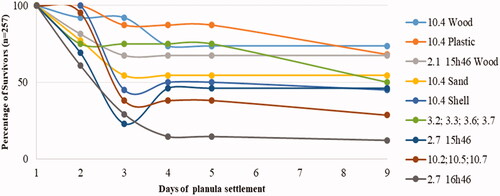Abstract
Introduction: Besides the knowledge of life cycles in nature, the sustained use of aquatic biological resources also requires the development of know-how to reproduce and maintain them in captivity [Citation1]. The scyphozoan Catostylus tagi, native to the Tagus and Sado estuaries, has already shown applicability in the areas of gastronomy and drugs for humans and has potential to be used as food for aquaculture organisms [Citation2]. In this work we started to investigate the benthic life stages of C. tagi and their maintenance in laboratory.
Materials and methods: In September 2017, gonads of 20 specimens of C. tagi (12 males and 8 females) were collected in the Tagus estuary. Pairwise samples of male and female gonads were placed in containers with 80 mL of Tagus water and different substrate for in vitro fertilization. The settlement, growth and survival of the polyps were monitored daily by microscope. The survival rate was calculated as the daily percentage of live polyps and planulae, relative to the total number of initial planulae (). Polyps were cultured under constant conditions of temperature (19 ± 1 °C) and salinity (34 ± 1 ‰) and kept in the dark to minimize the algae growth. When the polyps developed 6 tentacles, they were fed every 2 days, alternating between macerated female mussel gonads and rotifers supplied ad libitum. Waste particles and food remnants were removed daily from the containers. Between 20-50% of the water in each container was replaced with filtered Tagus water after the polyps had been fed. Statistical approach was made by Mann-Whitney U test, considering p <0.05.
Results: Polyp survival rate was high on the second day (∼81%), but with a marked fall on the day after, and a trend for stability with some decrease on the following days (∼50%) (). The highest survival rate was observed in containers that had substrate, specifically wood and plastic, while the lowest rate was observed in containers without substrate. Sand and shell were the substrates with the lowest results, the latter having a survival rate below 50% in the last days.
Discussion and conclusions: At the conditions of temperature and salinity used in this trial, statistical comparison confirmed that the survival rate of the polyps was significantly different in environments with and without substrate. Other authors observed similar rates of growth and survival in related species [Citation3].
Table 1. Survival data of Catostylus tagi polyps during the first 8 days of settlement.
Acknowledgements
This study was funded by Egas Moniz Coop Ensino Superior CRL, project EM-ZM 03/04.
References
- Goldstein J, Steiner UK. Ecological and demographic drivers of jellyfish blooms. bioRxiv. 2017;102814.
- Morais Z, Schiariti A, Morandini A. An interdisciplinary approach to the scyphozoans of the Atlantic Ocean. Chapter 5. In: Mariottini GL, editor. Jellyfish: ecology, distribution patterns and human interactions. New York: Nova Science Publishers. Inc., 2016. p. 1–62.
- Amorim K, Mattmüller RM, Algueró-Muñiz M, et al. Winter river discharge may affect summer estuarine jellyfish blooms. Marine Ecology Progress Series. 2018;591;253–265.

